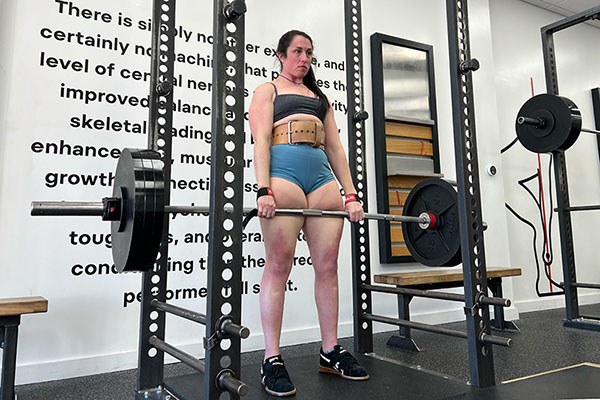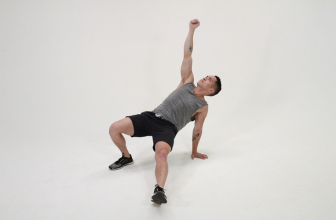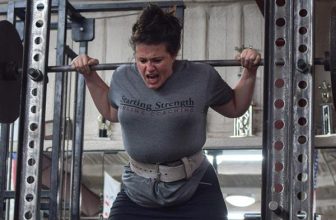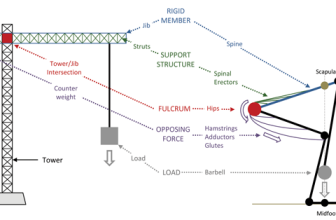
I have noticed an increasingly
common problem in barbell gyms, that I attribute primarily to
laziness. Yes, the rack pull exercise is easier to do than the full
pull off the floor. Yes, it’s easier to get into a good lumbar
extension if you don’t have to do it at the floor, where several
factors fight against the position. Yes, it’s a shorter pull from an
easier start position, about half the (force x distance) work than
the deadlift. Yes, the weight you can use is heavier, and you can
feel better about yourself. And yes, there is a good reason advanced
lifters use the rack pull after
the full deadlift gets heavy enough that it becomes a recovery
problem. But probably not for
you.
There
are only three types of trainees who should be using rack pulls
instead of a full range of motion deadlift.
1.
Advanced lifters who need a very heavy partial overload movement
using a reduced ROM – generally every other week alternated with
halting deadlifts for the bottom half of the pull. For these people,
the heavier weight contributes to the full movement while not tapping
in to recovery resources so far as to interfere with weekly progress.
2.
Intermediate lifters who need 2 heavy
pulling workouts a week to continue making weekly progress, but who
cannot recover from 2 full
deadlift workouts.
Like advanced lifters, these people need heavy work, but their
ability to recover has been compromised by their own ability to lift
heavier weights, and a partial movement is appropriate.
3.
The frail elderly or otherwise pathology-compromised individuals who
cannot
safely pull a bar from the floor.
Nobody
else has any business making their pulling artificially easier by
removing the part of the ROM that they don’t like – or that they
don’t like to coach. There is a legitimate reason for using partials
in training, but it always involves either recovery capacity or the
actual ability
to use a part of the normal human range of motion. When deadlifts get
so damned heavy that they adversely affect the rest of your training,
rack pulls and halting deadlifts (a partial pull from the floor to
just above the knee) can make this manageable while keeping the
weights heavy. And if you are a beat-up old guy with injuries that
make pulling from the floor a legitimately bad idea, you do what’s
necessary, and what you can.
The
real problem lies with coaches who’d rather not learn how to solve
the movement problems involved with new trainees pulling from the
floor. Lumbar flexion needs to be corrected, but correcting
it by using a position where it’s not actually a problem is not a
correction. That’s
like taking an Uber instead of learning how to drive. Everybody can
hold lumbar extension with the bar above mid-shin, but jumping your
client from deadlifts to rack pulls because the low-back is round off
the floor is an abdication of your responsibility to a paying
customer. Coaches: if you don’t know how to coach the floor pull,
either learn or stop charging for your services. You’re not being a
confrontational asshole when you correctly teach and cue for correct
technique and then firmly
insist on correct
technique – you’re being professional, and that’s what’s expected
of a professional barbell coach.
The
rack pull can be a useful teaching tool for working a pull down to
the bottom in lumbar extension. Start high, set the back, see how it
feels, pull it, lower the rack pins a little, set the back, see how
it feels, keep it locked, pull it, do it again a little lower –
back up and start over if necessary – and so on down to plates
touching the floor. But this correction happens in one
workout, not as a
replacement for the full deadlift as a basic exercise. You’re
teaching (or learning) how to hold the back in solid extension with
the spinal erector muscles and the abs in isometric contraction
through the whole range of motion, and how your breathing contributes
to this movement pattern. But once it is learned, it must be
practiced over the full pull from the floor, or it will never really
incorporate into the deadlift.
And
for those of you who say that you’ll just use rack pulls to get the
back strong enough to keep it flat off the floor, we have lighter
weights for that. Back up to 135. Bottom line: a correct floor pull
with a flat low back is a skill that allows strength to develop in
the parts of the musculoskeletal system that generate the position.
You can’t train the strength without the correct position and
neuromuscular control – you can’t strengthen the position if you
can’t hold the position under a load, and if you don’t know how to
set a flat back with high hips, you
have to learn. If
you don’t know how to pull off the floor correctly, or how to coach
it, you’re not going to learn either one by avoiding the position.
Deadlifts
are hard – that’s why we use them in training. They are sensitive
to technical errors: they must come off the floor directly over the
mid-foot, and the lats must keep them over this balance point all the
way to lockout. If you can deadlift 500 correctly, there are not many
strength-dependent physical tasks you can’t perform. Rack pulls are
hard too, but there is a qualitative difference: a 605×5 rack pull is
shorter and less technically delicate – you just get in the right
position (bar over mid-foot) and keep pulling the damn thing up your
legs until the set is finished. However, we don’t use rack pulls
because
they are technically easier, we use them because we can pull heavier
weights than we can off the floor without the recovery problems.
But
a novice having trouble with lumbar flexion at 185 is not a candidate
for what should be a heavy overload exercise for a much more advanced
lifter. Avoiding having to solve the movement pattern problem is
laziness on somebody’s part, and laziness is not productive in the
Grand Scheme of Things.
Discuss in Forums
Credit : Source Post






